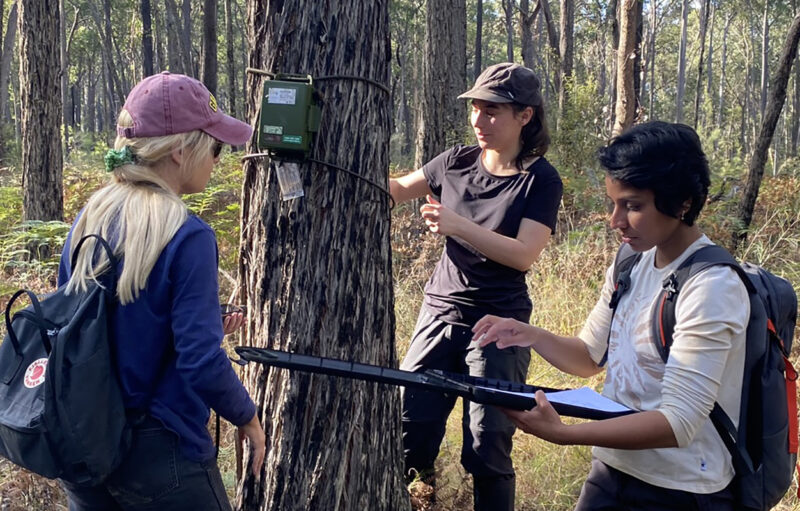PARK WATCH Article December 2023 |
Shannon Hurley, Nature Conservation Campaigner, on the efforts to rejuvenate our Golden Kelp forests
Golden Kelp is the backbone of our Great Southern Reef, but it is in serious decline across Port Phillip Bay’s marine sanctuaries.
The Port Phillip Bay Golden Kelp Restoration Project is being trialled to restore underwater kelp forests. This exciting project aims to test and develop techniques to halt and reverse the loss of Golden Kelp (Ecklonia radiata) and other macroalgae that form the bay’s kelp forest habitats.
The pilot at Jawbone and Ricketts Point Marine Sanctuaries will focus on reducing urchin abundance through culling in at least four hectares, and actively restoring up to one hectare of Golden Kelp, and protecting existing Golden Kelp and macroalgae habitats. Monitoring to track success of activities will also be carried out throughout the two-year project period (until December 2024).
Kelp forests are formed when species such as Golden Kelp, Giant Kelp (Macrocystis pyrifera) and Crayweed (Phyllospora comosa) form a canopy alongside other macroalgae. Golden Kelp forests can be found along the entire Great Southern Reef, which covers 8,000km of Australia’s coastline, while Giant Kelp is predominantly limited to south-east Australia. Kelp forests provide food and shelter for fish and other marine life like abalone, lobsters and cuttlefish.
How many urchins are too many?
Up until the 1980s, kelp and macroalgae habitat were widespread on the rocky reefs of the bay. Over the past few decades, changes in water quality and an abundance of overgrazing native Purple Sea Urchins (Heliocidaris erythrogramma) have pushed these habitats into decline.
The Purple Sea Urchin is native to Port Phillip Bay and is a natural part of a healthy kelp forest and macroalgae habitat. Urchins preferentially feed on drift algae, but will eat attached algae like kelp when drift is unavailable. When there are too many, they overfeed on algae and prevent it from regenerating. This leads to the formation of ‘urchin barrens’ which are devoid of macroalage and other sea creatures usually found in kelp forests and macroalgae habitat.
Urchin densities of around two per square metre are considered desirable for a healthy macroalgal system, but in some parts of Port Phillip Bay densities are as high as 60 urchins per square metre. More than 100 million urchins are estimated to be in the bay and at least 60 per cent of the bay’s reefs are impacted by urchin overgrazing.
Restoration program
In smaller scale trials and experiments in Port Phillip Bay, macroalgae has recovered where urchin numbers have been reduced, at Jawbone Marine Sanctuary for example. These restoration methods have been successful in other comparable locations (e.g. Tasmania).
The project will use novel techniques to research and develop the best methods to continue restoration works at a larger scale. Without this kind of innovative intervention, further loss of Golden Kelp forests and macroalgae habitat will continue in the bay.
Culling urchins is the first key step towards restoration and macroalgal regrowth in sea urchin barrens. Returning numbers to healthy levels of two per square metre, in at least four hectares of barrens across Jawbone and Ricketts Point Marine Sanctuaries, is critical.
Juvenile kelp will be grown on twine and gravel in Deakin University’s Queenscliff laboratory using reproductive tissue from healthy populations in Port Phillip Bay. This kelp will be planted by divers into barrens in marine sanctuaries after urchin numbers have been reduced. As they grow, it is hoped that they will naturally attach themselves to the reef substrate and hopefully reproduce to form a new canopy.
The areas will be monitored before, during and after culling and restoration. A robust monitoring plan has been developed to inform future restoration efforts and allow comparison to areas where no culling or restoration occurs.
Why are we intervening in marine sanctuaries?
To select restoration sites, the current and historic extent of both kelp forest and macroalgal habitats was considered, as well as the existence of urchin barrens at Jawbone and Ricketts Point Marine Sanctuaries. Video surveys were conducted to map the extent of existing habitats and considered in conjunction with historic data. Sites are in barren areas near remnant kelp and macroalgae habitat as restoration is more likely to succeed in proximity to remnant kelp patches.
Victoria’s network of marine parks was established in 2002 to protect representative and important marine habitats. We need to prevent the loss of important habitats such as kelp forests and macroalgae for these parks to achieve their important purpose: to support biodiversity. Intervention is required to help restore the values of these sanctuaries.
The Golden Kelp restoration project brings together Victoria’s leading organisations working with kelp and urchin research, management and restoration. It is a partnership between the University of Melbourne, The Nature Conservancy, Deakin University and Parks Victoria. It is funded by the Department of Energy, Environment and Climate Action.
Read more at natureaustralia.org.au/what-we-do/our-priorities/oceans/ocean-stories/kelp-forest-in-port-phillip-bay
- Read the latest full edition of Park Watch magazine
- Subscribe to keep up-to-date about this and other nature issues in Victoria
- Become a member to receive Park Watch magazine in print
